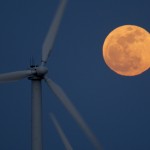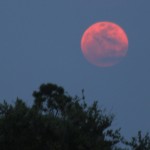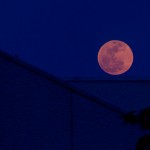Looking Up at the Supermoon From Texas (and Beyond)
- The “supermoon” is seen from Mexico city on 05 May 2012. The full moon on this day, the biggest of the year, is at 352.947 Kms, the shortest distance to earth in the year.
- The Supermoon, as seen from onboard Groupama Sailing Team during leg 6 of the Volvo Ocean Race 2011-12 on May 5, 2012 from Itajai, Brazil, to Miami, North America.
- A perigee moon, or SuperMoon, rises behind wind turbines on May 5, 2012 near Palm Springs, California. The moon appears especially big and bright during this once-a-year cosmic event as the full moon is at its closest to the Earth in its elliptical orbit. The perigee side of its orbit is about 31,000 miles closer than the opposite, or apogee, side. The bright light of the full moon also hides all but the brightest meteors of the Eta Aquarid meteor shower, the remnant debris trail of Halley’s Comet.
- A perigee moon, or supermoon, rises behind wind turbines on May 5, 2012 near Palm Springs, California. The moon appears especially big and bright during this once-a-year cosmic event as the full moon is at its closest to the Earth in its elliptical orbit. The perigee side of its orbit is about 31,000 miles closer than the opposite, or apogee, side. The bright light of the full moon also hides all but the brightest meteors of the Eta Aquarid meteor shower, the remnant debris trail of Halley’s Comet
- The “supermoon” is seen May 5, 2012 from Chevy Chase, Maryland. The biggest and brightest moon of the year is due to the moon being at its closest point to the earth during its orbit.
- A haze obscured many views of the supermoon in Texas.
- It was a bit cloudy when the Super Moon made its appearance.
- As seen rising over the mexican american cultural center in Austin, Texas
Parts of Texas got a peek at one of the coolest lunar moments of the year last weekend. In the late hours of Saturday night, the earth was graced with a close-up of the moon when a full moon hit at the same time as the moon’s nearest orbit to earth (the technical term is perigee-syzygy, but “supermoon” is admittedly more fun). The moon was about thirty percent brighter and fourteen percent bigger, which made it the biggest full moon of the year.
Much of the East Coast got clouded out and couldn’t see the full lunar glory, and Central Texas was hit by severe thunderstorms right as the peak of the supermoon occured. But other parts of Texas were blessed with intermittently clear skies to witness the event. In the slideshow above, you can see images of the supermoon taken across Texas and other parts of the world. Discovery News also has a slideshow with photos submitted by readers.







